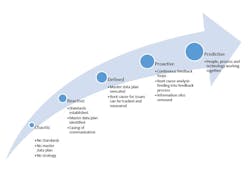It’s that time of year. The beginning of a new year often means that many of us are preparing our resolutions. Whether your resolution is to improve your diet, lose weight or quit smoking, there is one piece of advice that’s broadly applicable when it comes to achieving any resolution. You’re far more likely to achieve your resolution goal if you have a clear plan in place.
The desire to lose weight or the desire to quit smoking in and of itself is not a plan to get there; it is the destination but not the map. Having a small child at home, I’ll pull out some of my dad advice when it comes to developing a plan to achieve something.
How do you eat an elephant? One bite at a time. All good plans involve taking what might seem like overly ambitious goals and breaking them down into smaller baby steps.
In the business world, and in the world of EHS and quality in particular, a common goal that many organizations are setting for themselves is to go from reactive to proactive in their decision making. But that goal, just like a desire to quit smoking, is just a goal rather than the baby steps to get there.
So is there a simple plan or smaller bites to take an organization from a reactive state to a state of using EHS and quality data proactively to create a safer organization?
Yes, there is. Let’s look at the five steps you can take your organization from reactive to proactive data-driven decision making and beyond.
1. Chaotic
The reality is that many organizations are really starting from square one when it comes to unlocking the value of their data assets. That’s okay. Years of manual, paper and Excel-driven processes have left many organizations with a tremendous amount of data sprawl that can be difficult to manage.
What this translates into is a chaotic state for much of the data. Because of this sprawl, it is difficult, if not impossible, to create and maintain standards when it comes to data. What this often translates into for organizations is a lack of a plan when it comes to their data (think of this as a plan to consistently answer who, what, where, when, why of the data they track). This lack of standards and plan leaves organizations without the ability to plan for or execute a data strategy.
But that’s okay. There are several steps along the way to data-driven decisions and this is just the starting point.
2. Reactive
The next step in building towards data-driven decisions is to begin establishing standards when it comes to the data you capture, track and maintain. For EHS or quality professionals this could mean taking a look at the manually captured data you currently have and defining a consistent framework or template for what it should look like.
Once those standards are established, then organizations can begin to make reactive decisions based on what the data is telling them. This is an important step in beginning to formulate a master data plan and also in easing the communication of data insights through an organization.
3. Defined
Once your EHS or quality data is scrubbed to the point where you are able to make reactive decisions, the next step is to look at the (now standardized) datasets being gathered to start executing on a long-term master data plan. This plan should consider not only where the data is today, but how the data may evolve moving forward.
With this consistency in data, analysts can perform like-for-like comparisons. What this translates to in the real world for EHS pros is root cause analysis. The first major outcome of consistency in data capture and a master data plan is this ability to compare data from one time period to another. In other words, at this stage trending analysis and regression analysis becomes a reality and root causes can now be identified for persistent or concerning problems.
4. Proactive
With a master data plan in place, the stage can now be set for proactive, insight-driven decision making.
As with other stages in this model, the proactive stage is all about doing the things you started doing previously on an ongoing basis. In this case, that means using your initial root cause analysis as a starting point for continuous feedback loops. Ongoing data-driven root cause analysis allows for information silos to be removed in an organization. This proactive analysis can now allow an organization to see patterns that it would otherwise not be able to see. In the context of safety, what this means is that hazards and dangers can be addressed before they might even surface
5. Predictive
At this point, we’re at the final stage in the maturity of your data usage: predictive. That means people, process and technology working together. This stage is less about technology and data, and more about establishing consistency in communication and process across all the stakeholders in your organization.
While going from reactive to proactive and predictive data-driven decisions sounds easy on the surface, the reality is that it’s a journey that will take most organizations several steps. This simple five-point plan is just one of several options, but hopefully it can help give you some ideas and direction as your organization executes against your own data strategy.
Is moving from reactive to proactive and uncovering more value from your EHS and quality data an objective for your organization in 2016? I'd love to hear your thoughts in the comment section.
This article originally appeared on the Intelex Health and Safety Blog.
About the Author
Jason Dea
Director of Product Marketing
Jason Dea is the Director of Product Marketing at Intelex. There he works with the Intelex team to deliver their market leading occupational health and safety software solutions. He is an accomplished marketer with over 10 years’ experience helping develop the product roadmap and launching successful ROI-driven products to sustain business growth.

